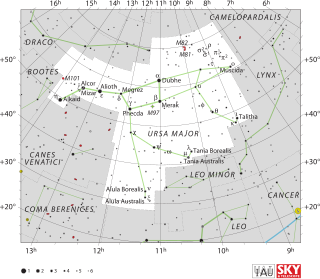Merak
Appearance
| Observation data Epoch J2000.0 Equinox J2000.0 | |
|---|---|
| Constellation | Ursa Major |
| Right ascension | 11h 01m 50.47654s[1] |
| Declination | +56° 22′ 56.7339″[1] |
| Apparent magnitude (V) | +2.37[2] |
| Characteristics | |
| Spectral type | A1IVps[3] |
| U−B color index | +0.00[2] |
| B−V color index | -0.02[2] |
| Variable type | Suspected |
| Astrometry | |
| Radial velocity (Rv) | -12.0[4] km/s |
| Proper motion (μ) | RA: +81.43[1] mas/yr Dec.: +33.49[1] mas/yr |
| Parallax (π) | 40.90 ± 0.16[1] mas |
| Distance | 79.7 ± 0.3 ly (24.45 ± 0.10 pc) |
| Absolute magnitude (MV) | +0.61[5] |
| Details | |
| Mass | 2.7[6] M☉ |
| Radius | 3.021 ± 0.038[7] R☉ |
| Luminosity | 63.015 ± 1.307[7] L☉ |
| Surface gravity (log g) | 3.83[8] cgs |
| Temperature | 9377 ± 75[7] K |
| Rotational velocity (v sin i) | 46[9] km/s |
| Age | 500 ± 100[8] Myr |
| Other designations | |
| Database references | |
| SIMBAD | data |
Merak or Beta Ursae Majoris is a star in the constellation Ursa Major. It is a white star three times larger than the Sun.[7] It is a part of an asterism called the Big Dipper.

Related pages
[change | change source]References
[change | change source]- ↑ 1.0 1.1 1.2 1.3 1.4 van Leeuwen, F. (November 2007). "Validation of the new Hipparcos reduction". Astronomy and Astrophysics. 474 (2): 653–664. arXiv:0708.1752. Bibcode:2007A&A...474..653V. doi:10.1051/0004-6361:20078357. S2CID 18759600.
- ↑ 2.0 2.1 2.2 Johnson, H. L.; et al. (1966), "UBVRIJKL photometry of the bright stars", Communications of the Lunar and Planetary Laboratory, 4 (99): 99, Bibcode:1966CoLPL...4...99J
- ↑ Phillips, N. M.; Greaves, J. S.; Dent, W. R. F.; Matthews, B. C.; Holland, W. S.; Wyatt, M. C.; Sibthorpe, B. (2010). "Target selection for the SUNS and DEBRIS surveys for debris discs in the solar neighbourhood". Monthly Notices of the Royal Astronomical Society. 403 (3): 1089. arXiv:0911.3426. Bibcode:2010MNRAS.403.1089P. doi:10.1111/j.1365-2966.2009.15641.x. S2CID 119262858.
{{cite journal}}: CS1 maint: unflagged free DOI (link) - ↑ Evans, D. S. (June 20–24, 1966). "The Revision of the General Catalogue of Radial Velocities". In Batten, Alan Henry; Heard, John Frederick (eds.). Determination of Radial Velocities and their Applications, Proceedings from IAU Symposium no. 30. Determination of Radial Velocities and Their Applications. Vol. 30. University of Toronto: International Astronomical Union. p. 57. Bibcode:1967IAUS...30...57E.
- ↑ Eggen, Olin J. (August 1998), "The Sirius Supercluster and Missing Mass near the Sun", The Astronomical Journal, 116 (2): 782–788, Bibcode:1998AJ....116..782E, doi:10.1086/300465.
- ↑ Wyatt, M. C.; et al. (July 2007), "Steady State Evolution of Debris Disks around A Stars", The Astrophysical Journal, 663 (1): 365–382, arXiv:astro-ph/0703608, Bibcode:2007ApJ...663..365W, doi:10.1086/518404, S2CID 18883195
- ↑ 7.0 7.1 7.2 7.3 Boyajian, Tabetha S.; et al. (February 2012), "Stellar Diameters and Temperatures. I. Main-sequence A, F, and G Stars", The Astrophysical Journal, 746 (1): 101, arXiv:1112.3316, Bibcode:2012ApJ...746..101B, doi:10.1088/0004-637X/746/1/101, S2CID 18993744. See Table 10.
- ↑ 8.0 8.1 Monier, R. (November 2005), "Abundances of a sample of A and F-type dwarf members of the Ursa Major Group", Astronomy and Astrophysics, 442 (2): 563–566, Bibcode:2005A&A...442..563M, doi:10.1051/0004-6361:20053222
- ↑ Royer, F.; Zorec, J.; Gómez, A. E. (February 2007), "Rotational velocities of A-type stars. III. Velocity distributions", Astronomy and Astrophysics, 463 (2): 671–682, arXiv:astro-ph/0610785, Bibcode:2007A&A...463..671R, doi:10.1051/0004-6361:20065224, S2CID 18475298
- ↑ Allen, Richard Hinckley (1899), "Star-names and their meanings", New York, G. E. Stechert: 438, Bibcode:1899sntm.book.....A
- ↑ "MERAK -- Variable Star", SIMBAD, Centre de Données astronomiques de Strasbourg, retrieved 2012-01-01

